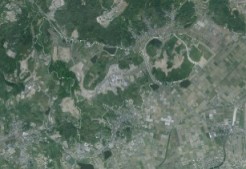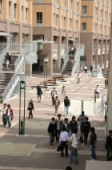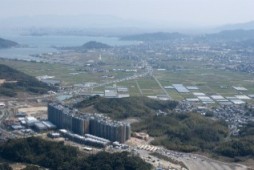University Summit in Kyushu 2007
Kyushu University, Fukuoka,
Japan, 27-28 October
Session 1(Part1): The "Science City" of the Future and the Environment
Prof. Dr. Takeru SAKAI
Faculty of Engineering, Kyushu University
ITO New Campus and Academic City
Towards Creation of a Campus in the 21st Century
Based on the concepts "autonomous change with the times and construction of an open university that maintains vitality" and "creation of education and research centers appropriate for this," Kyushu University is constructing ITO New Campus in an area spanning the Motooka/ Kuwabara district in Fukuoka City's Nishi-ku, Maebaru City, and Shima-machi. It will relocate and integrate its Hakozaki Ropponmatsu, and Haru-machi campuses there. In October 2005, the university's engineering-related faculties moved to the New Campus and began activities there. Located in a convenient suburb amidst the rich natural area of the Itoshima Peninsula, the New Campus operates as the core of an academic city built on cooperation among industry, government, and academia.
Framework and guidelines for consistent long-term campus development have been collected in the gKyushu University New Campus Master Plan 2001h. In the Master Plan, nine targets are laid out, pointing to the creation of an excellent research and educational environment: "Coexistence of a symbolic space that creates its own traditions and a space which can flexibly change and regenerate," "Symbiosis of the eternal history and natural surroundings of the Itoshima region," and "Development of a safe and comfortable campus environment." Directives were laid out with regard to the establishment of an objective for the entire campus and a concept for the formation of space, land use, traffic conditions, infrastructure, internal spaces for research and education facilities, and phased construction and development. A block plan for Engineering, Science and Center zones has been created based on the Master Plan. Architectural design and building construction are proceeding according to this plan.
The new Kyushu University is being created so as to have a special character of its own. In the gPublic Space Design Manualh, general design policies have been compiled for public spaces to be developed throughout the campus. The components of these design policies (landscape, colors schemes, signage, trees and plants, lighting and so on) will create an attractive campus with a distinct personality and a sense of unity.
The spacious Ito Campus is located on 275 ha, spreading across approximately 3 km east to west and 2.5 km north to south. It is located in the center of the Itoshima Peninsula, which is west of Hakata Bay, about 15 km and a 40-minute ride by public transportation from Tenjin in the heart of Fukuoka. Although the area is a convenient suburb of a major city, it is located in a tranquil environment with much nature remaining overlooking the Sea of Genkai. The many ruins in the area attest to its rich history and the flourishing comings and goings of people there in ancient times. Plans call for a population of about 16,000, with facilities with a total floor area
of
500,000 u.
Buildings for Engineering are finished. The Sciences and Technology Library and facilities for supplying energy and water are almost completed. Nearby, urban renewal and construction of the Gakuen Dori Line by Fukuoka City proceeding at a rapid pace, and the new JR station (Kyudai-Gakkentoshi Station) is in place. Aiming to be an acceptable university, Students (including foreign students) and on-campus nonprofit organizations has already begun the interaction with the local community.




@@@@@@@@@@@@Photo 1,2 ITO New Campus@@@@@@@@@@@@@@@@ Photo 3 Direction of the downtown of Fukuoka